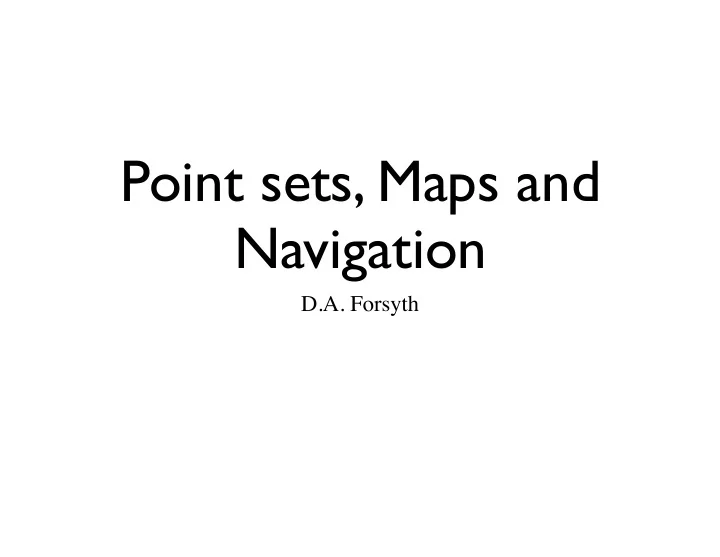

Point sets, Maps and Navigation D.A. Forsyth
Issues • Where am I? • Simplest: register observations and motion to a map • correspondence and robustness • Build a map • Register observations to one another • global consistency • Incorporating motion models • Registration should benefit from knowledge of motion • Filtering
Simplest case • Registration with known correspondence • No motion model • 3D observations of known beacons at known 3D locations • beacons y_i; observations x_i • (for generality) weights w_i • Problem: • choose rotation R, translation t to minimize w i ( R x i + t − y i ) T ( R x i + t − y i ) X C ( R, t ) = i • THIS CAN BE DONE IN CLOSED FORM!
The translation • Solve for translation as function of R X X X r t C = 0 = R ( w i x i ) + t ( w i ) � ( w i y i ) i i i • So Weighted centroids t = y − R x • Plug this into cost function to get w i ( R ( x i − x ) − ( y i − y )) T ( R ( x i − x ) − ( y i − y )) X G ( R ) = i
The rotation w i ( R ( x i − x ) − ( y i − y )) T ( R ( x i − x ) − ( y i − y )) X G ( R ) = i • Substitute w i ( R ( u i ) − ( v i )) T ( R ( u i ) − ( v i )) X G ( R ) = i • Expand X u T i u i − 2 v i R u i + v T ⇥ ⇤ G ( R ) = w i i v i i • So MAXIMIZE X H ( R ) = w i v i R u i i
The rotation X H ( R ) = w i v i R u i • Rewrite using i U = [ u 1 , u 2 , . . . ] • To get: WV T RU ⇥ ⇤ H ( R ) = Trace • Rotate through Trace to get: RUWV T ⇤ ⇥ H ( R ) = Trace • Rewrite This is data H ( R ) = Trace [ RD ]
The SVD (in case you don’t recall!) D = A Σ B T • For any D • A is orthonormal, B is orthonormal, Sigma is diagonal • by convention, diagonal values are sorted by magnitude • we drop zero diagonals, and corresponding columns of B, A^T • they don’t do anything • A staple of numerical analysis • stable, well-behaved, etc. algorithms easily available • partial SVDs available • works fine at very large scales • generally, a good thing
The rotation H ( R ) = Trace [ RD ] • SVD data D = A Σ B T • Substitute, and rotate: Σ B T RA RA Σ B T ⇤ ⇥ ⇥ ⇤ H ( R ) = Trace = Trace • This must be orthonormal!
The rotation • We must maximise: H ( R ) = Trace [ Σ M ( R )] • (where M(R) is orthonormal) • But this means that M(R) has 1 or -1 on the diagonal! • So if Σ B T RA RA Σ B T ⇤ ⇥ ⇥ ⇤ H ( R ) = Trace = Trace • the orthonormal matrix we’re looking for is: R = BA T
Final details • Careful: R = BA T • could be a reflection (ie det=-1; a flip; etc.) • Fix: 1 , 1 , det( BA T ) ) A T ⇥ ⇤ R = B (diag
So far • Given two sets of points • with known correspondences • weights • We can find optimal rotation, translation to register • easily • in closed form • We now know where we are • for (say) x_i 3D measurements, y_i beacons • Missing: • what happens if we *don’t* have correspondences? • robustness
ICP = Iterated closest points • What if we *don’t* have correspondences? • Idea: • Repeat until convergence: • each x corresponds to “closest” y • register • Big simple idea, lots of variants • What is “closest”? • What if you have lots of points?
• Full set of slides is on web page • I’m going to show some to make major points
The issue here is efficiency - also, some points are more helpful than others (think corners)
Uniform samples are shakey - stratify 1 1 0.9 0.9 0.8 0.8 0.7 0.7 0.6 0.6 0.5 0.5 0.4 0.4 0.3 0.3 0.2 0.2 0.1 0.1 0 0 0 0.1 0.2 0.3 0.4 0.5 0.6 0.7 0.8 0.9 1 0 0.1 0.2 0.3 0.4 0.5 0.6 0.7 0.8 0.9 1 Uniform Block stratified
Q: who corresponds with who? Doesn’t have to be closest!
Speeding this up (in low D) • We care about 2D, 3D • Some correspondence errors may be tolerable. • We’re making pooled estimates of rotation and translation • Idea • target points into octree (kd tree, etc) • closest point *within tree cell* • which may not be the overall closest point! • whatever! • Other hashing procedures could apply • but mostly more trouble than necessary in 2 or 3 D
Warning - KD trees aren’t exact This doesn’t usually *matter* but…
Recommend
More recommend